

Damion Smy
Hyundai i30 N TCR celebrates 10 years of ‘N’ with Gran Turismo 7 debut
5 Days Ago
It's pricier than before, but the redesigned, eighth-generation Volkswagen Golf packs more technology and a minimalistic new cabin.
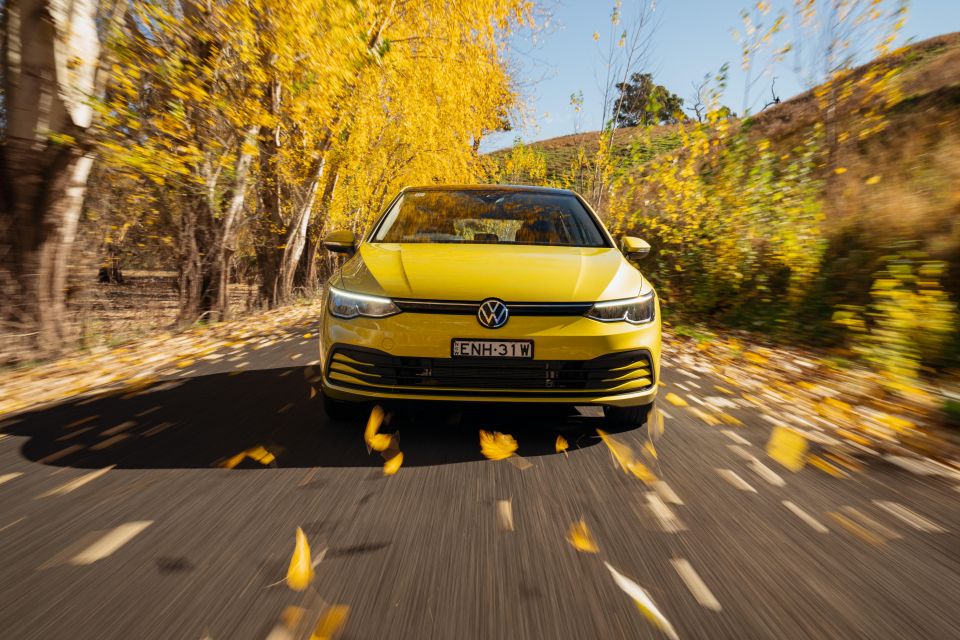
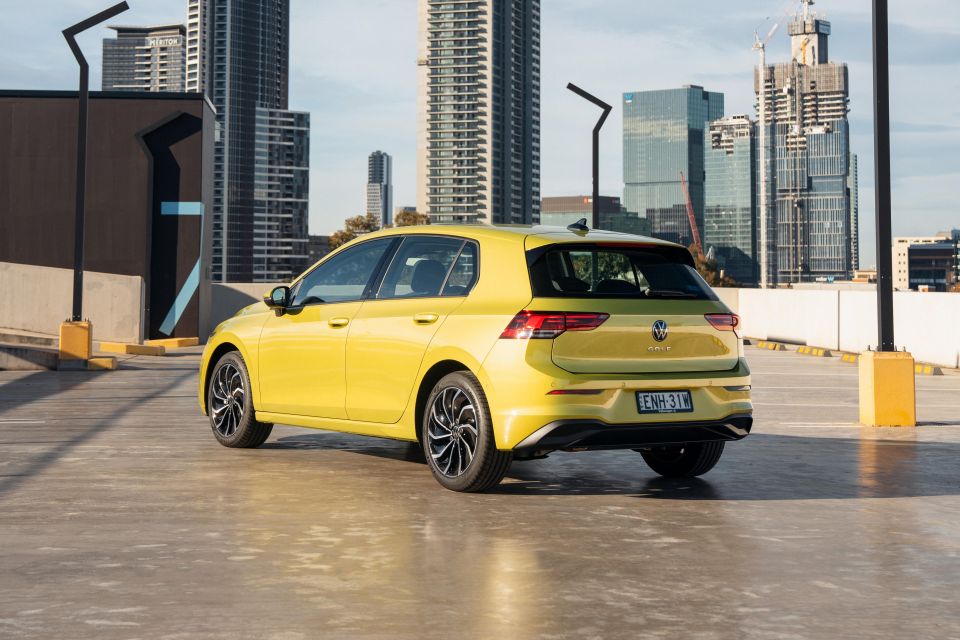

News Editor
New from
$29,350
excl. on-roads

News Editor
New from
$29,350
excl. on-roads


News Editor
New from
$29,350
excl. on-roads

News Editor
New from
$29,350
excl. on-roads
Quickly see how this car stacks up against its competition. Select any benchmark to see more details.
Where expert car reviews meet expert car buying – CarExpert gives you trusted advice, personalised service and real savings on your next new car.
The launch of a new Volkswagen Golf is still an important one for the company in Australia, though it’s not quite as critical as it once was.
It isn’t the early 1990s anymore, where Volkswagen Australia sold only Golfs, vans and a handful of Passats. Since that time, as the company’s fortunes have grown in Australia, so too has its range of products.
Now, Volkswagen says the Golf is but a single pillar in its colonnade of successful vehicles, from the Tiguan – expected to become the brand’s best seller locally – to the Amarok ute and the recently launched T-Cross and T-Roc crossovers.

For many buyers, Golf remains synonymous with Volkswagen. To that end, the company is still offering a wide range with its redesigned Mk8 model. The high-riding Alltrack wagon may be gone from Australia, but there are still hatch and wagon options in the core range, plus the hotter GTI hatch and the hottest R hatch and wagon (coming 2022).
Volkswagen never rocks the boat too much with its Golf redesigns. While some of us bristled at the sight of the Mk8 Golf when it was revealed in 2019, its ultimately quite evolutionary styling is hardly controversial. That said, to some the outgoing Mk7.5 is arguably prettier.
Pricing is up for the new Mk8 compared to the last car, but Volkswagen points out there’s been a commensurate increase in the level of standard kit. We’ve put the mid-range 2021 Volkswagen Golf 110TSI Life hatchback to the test to see how it stacks up.

The Mk8 Golf range opens at $29,350 before on-road costs for the unnamed base model with its standard six-speed manual transmission. Adding an auto raises the price to $31,950 before on-roads.
The auto-only 110TSI Life on test costs $34,250 before on-road costs, with the sportier looking $37,450 110TSI R-Line the last stop before you reach the $53,100 GTI.
Rivals for the Golf Life include the Kia Cerato Sport+ ($31,690), Hyundai i30 N Line auto hatch ($31,420), Mazda 3 G25 GT auto ($35,290), Honda Civic RS ($35,600), Subaru Impreza 2.0i-S ($31,490) and Toyota Corolla ZR hatch ($32,695, add $2000 for the hybrid).
Perhaps its most direct rival is one of its fiercest competitors back home in Europe: the Ford Focus. In ST-Line trim it undercuts the Golf at $30,990 before on-roads, though adding the $1250 Driver Assistance Pack narrows the gap somewhat.
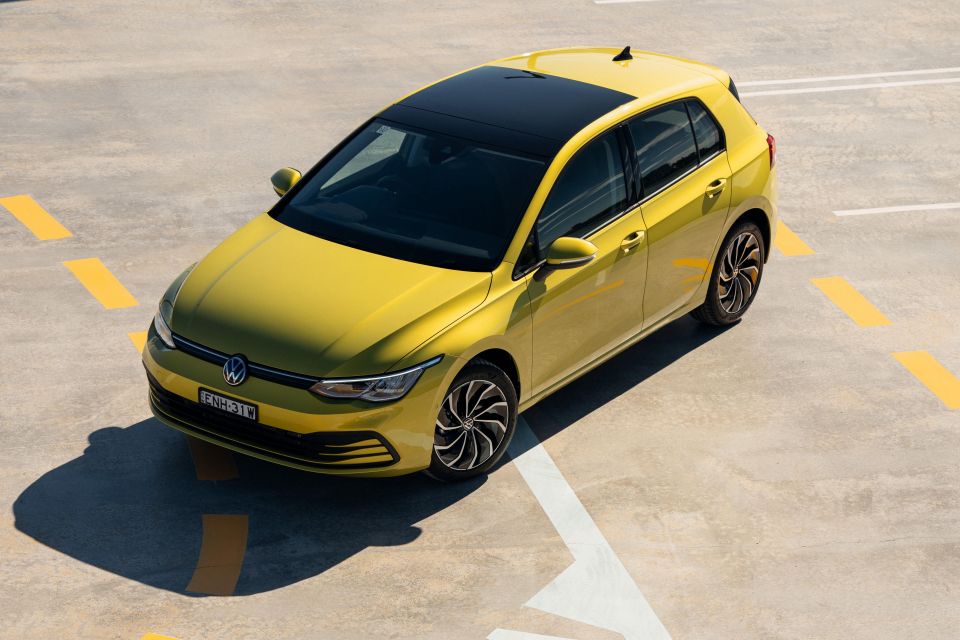
The Skoda Scala 110TSI Monte Carlo, priced at $33,390, may be based on the smaller Volkswagen Polo’s MQB A0 platform but it features the same power and torque outputs as the Golf. However, you need to shell out another $4300 to get a comparable level of safety equipment to the Golf.
The Golf Life is painted in Alpine White as standard, with premium paint a $600 option for Atlantic Blue, Dolphin Grey and Reflex Silver metallic finishes and Deep Black Pearl.
As for our tester’s finish, they call it Pomelo Yellow (quite rightly!). This shade really does resemble that of a pomelo or, if you haven’t heard of the citrus, it’s perhaps closest to Lemon-Lime Gatorade. It costs $900.
All up, with its vibrant paint colour and both available option packages, our tester rang up at $38,650 before on-road costs.
The Life replaces the Mk7.5’s 110TSI Comfortline spec. Strip away the option packages of our tester and its price is still $4460 than the old Comfortline. It isn’t quite that simple, though.
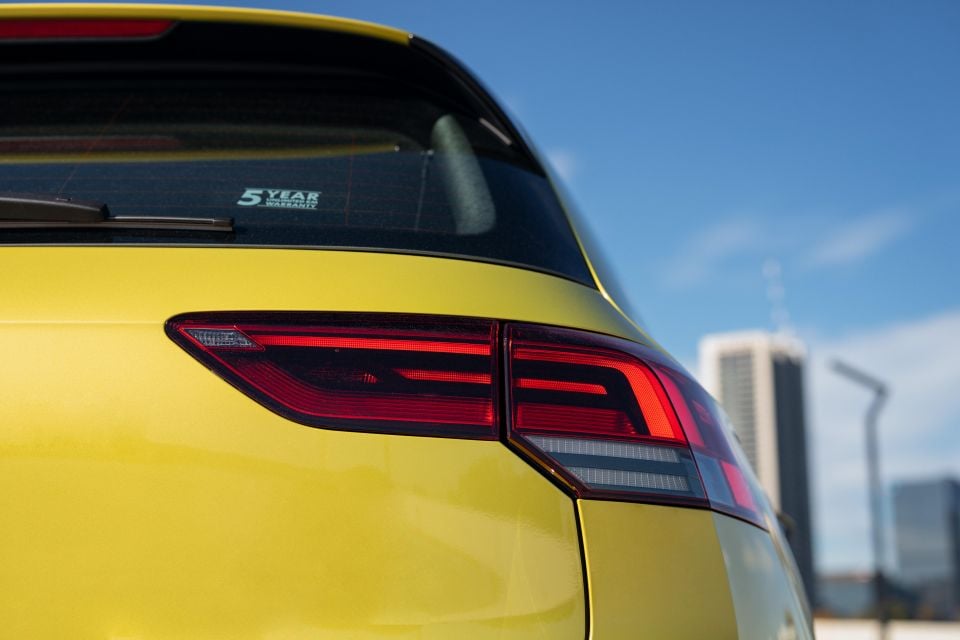
Buy your new car without the stress. It's fast, simple and completely free.

Great service from Travis and team, second time I have used this business would not hesitate to recommend them to anyone
Craig C.
Purchased a Ford Ranger in Sunshine Coast, QLD
CarExpert helped Craig save thousands on his Ford Ranger, now let us save you on your next new car.
Find a dealWith the new Mk8 range, a raft of active safety and driver assist features – marketed under the IQ. Drive banner – are now standard across the range instead of being part of a $1500 option package.
That narrows the price gulf to $2960, though there are other features that weren’t on the old Comfortline. These include:
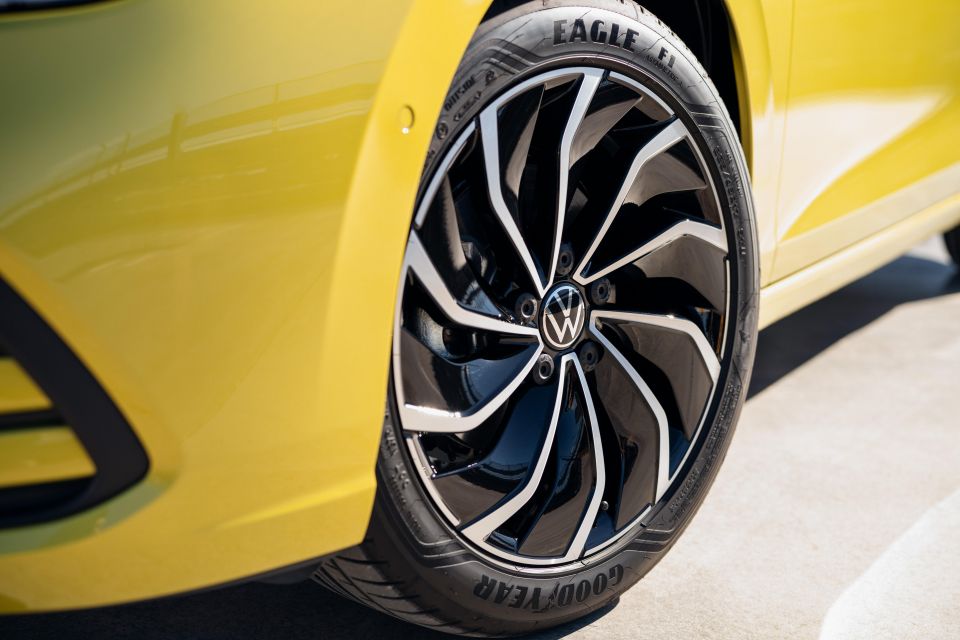
Other standard kit on the Life includes:
That’s in addition to features found at the base level, such as:
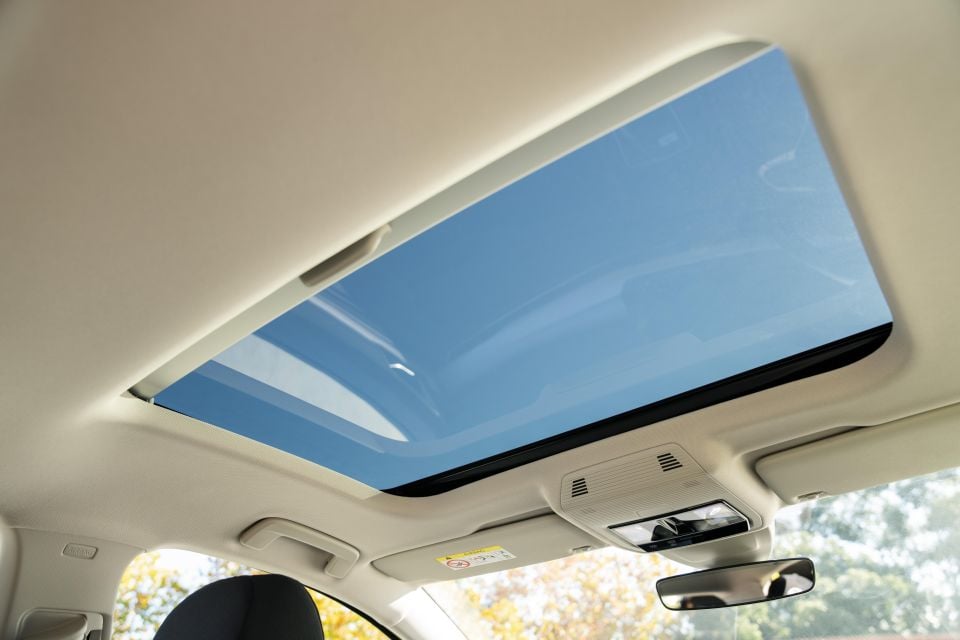
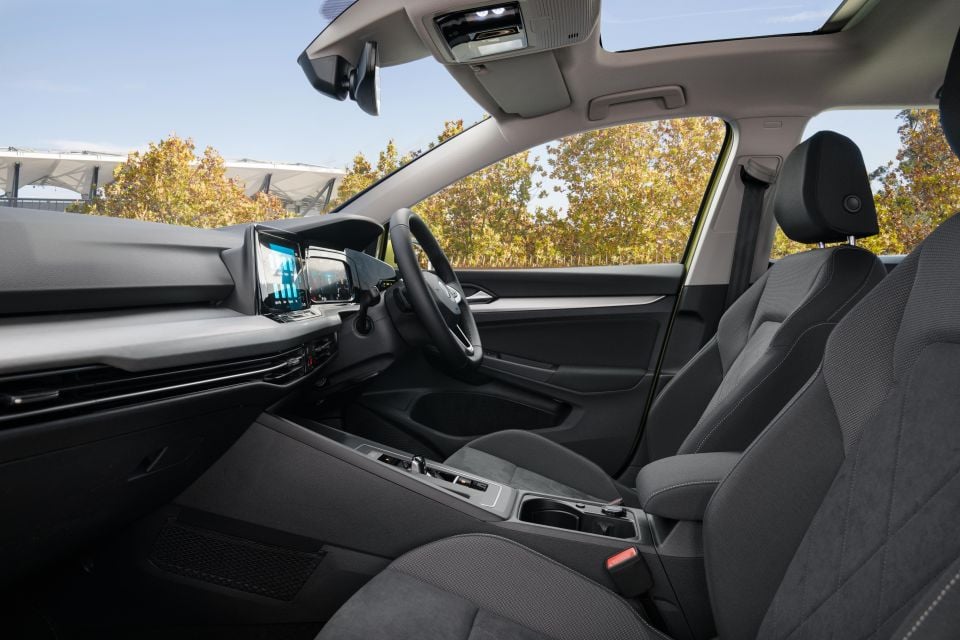
There are two available option packages, both of which were fitted to our tester.
The $1500 Sound and Vision package adds a head-up display and an eight-speaker Harman Kardon 480W sound system.
The $2000 Comfort and Style package adds microfleece-trimmed sport seats, 30-colour adjustable ambient lighting, and what Volkswagen calls a panoramic sunroof. It’s not – it’s scarcely bigger than a conventional, single-pane unit.
Those seats, however, look fantastic. They’re somewhat reminiscent of the seats in the Skoda Octavia RS, and manage to feel both cushy and supportive. While we imagine the regular cloth seats are perfectly fine, the Comfort and Style package is almost worth the outlay just for those. If only you could just get the seats and the head-up display in one pack!
Set aside the option packages and the Ford Focus ST-Line offers a similar level of specification to the Golf Life, at least once you add the Driver Assistance Pack. While it misses out on a digital instrument cluster, a head-up display and semi-autonomous parking assist, it has automatic high-beam and traffic sign recognition in its favour.
The Koreans don’t line up as neatly with the Golf. For slightly less than the Golf Life, you can get a less powerful Kia Cerato Sport+ or a more powerful but less well-equipped Hyundai i30 N Line hatch. If you want a Korean that has the same or more power and torque than the Golf Life and a comparable level of equipment, you’re looking at spending over $36,000 before on-roads.
The Toyota Corolla ZR also misses out on a fully-digital instrument cluster, but it has more speakers (nine), heated front seats, a head-up display and a power driver’s seat. As for the Mazda 3, even in G25 Evolve trim it packs a power driver’s seat and head-up display, but step up to the GT and you get leather upholstery and a 12-speaker Bose sound system.
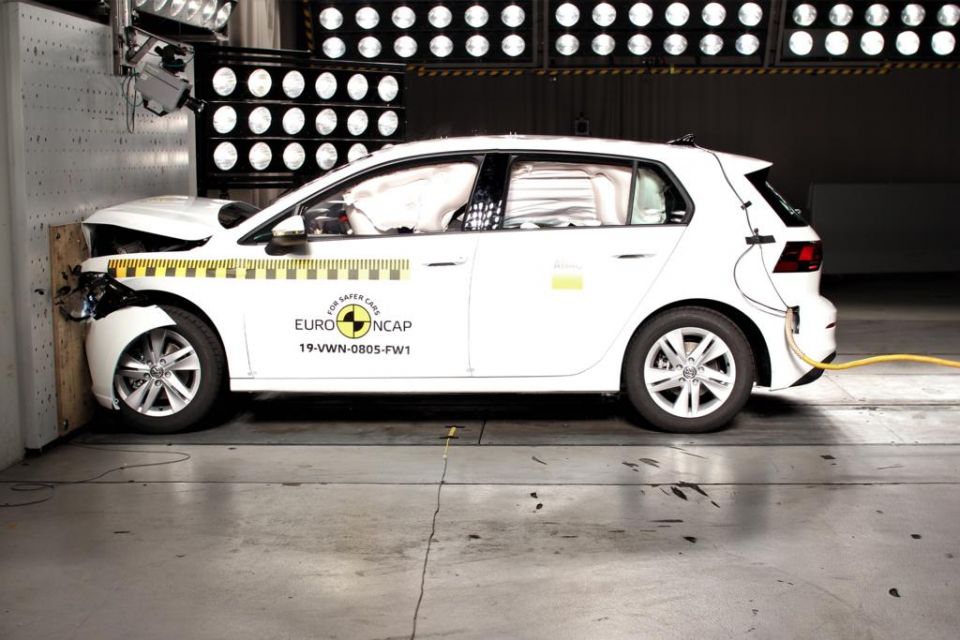
As mentioned, the Golf now comes standard across the range with the IQ. Drive suite of technology. That includes:
That’s a significant jump up from the old 110TSI Comfortline, where only AEB was standard and almost everything else was bundled into an option package.
Life and up add safe exit warning and Emergency Assist, though you need to step up to the R-Line to get automatic high-beam.
All Golf models also include front airbags plus side and curtain airbags for both rows.
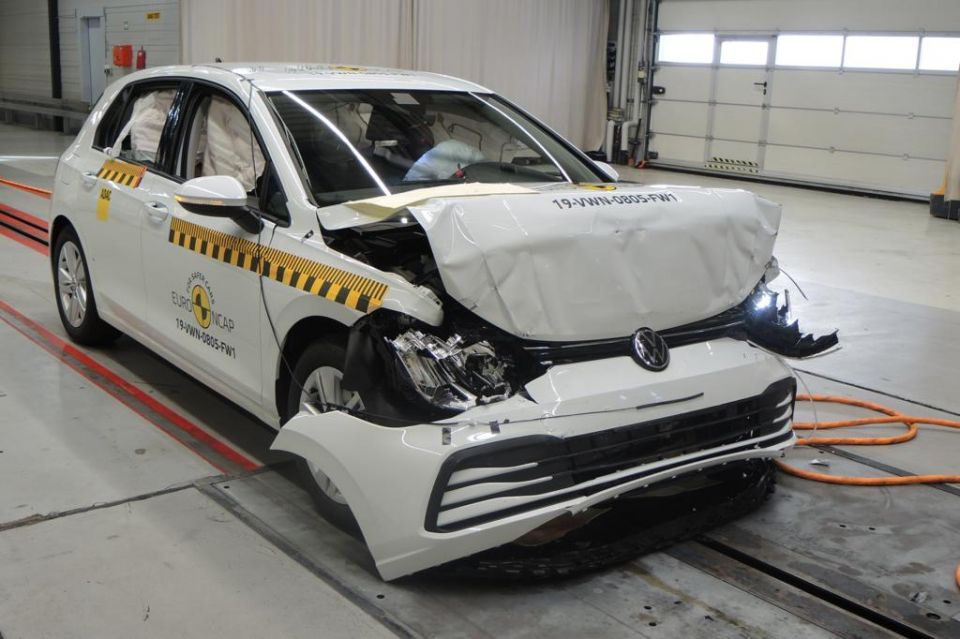
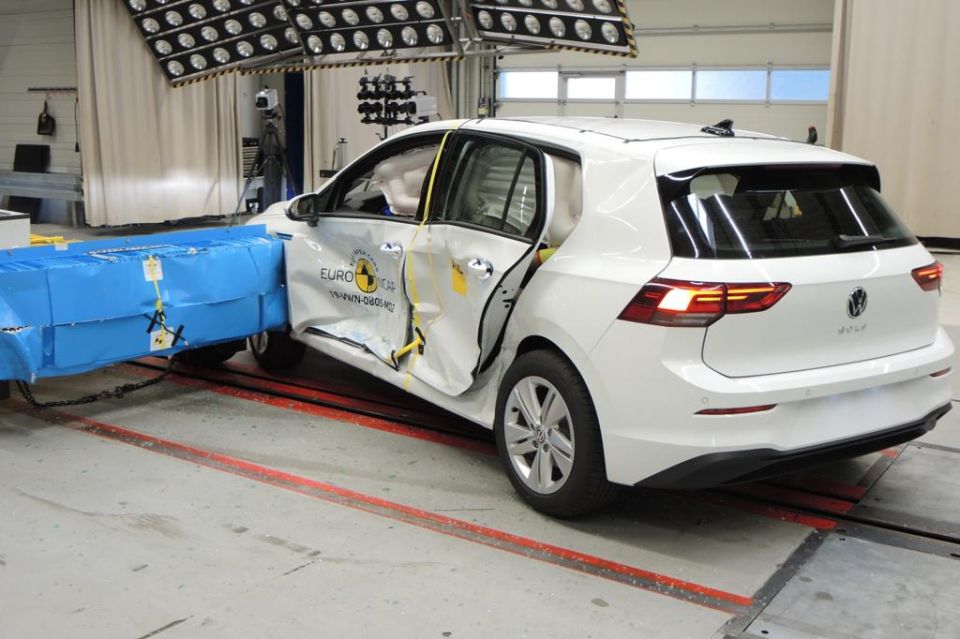
There’s also Travel Assist and Traffic Jam Assist, which both use the adaptive cruise control and adaptive lane guidance to provide partially autonomous driving.
The clever Emergency Assist will bring your Golf to a stop, unlock the doors and turn on all the interior lights if it detects no driver activity even after it’s prompted you.
The AEB system, which Volkswagen calls Front Assist, works at speeds of between 5 and 250km/h for vehicles and cyclists and between 5 and 85km/h for pedestrians.
The Golf has a five-star ANCAP rating based on testing carried out by Euro NCAP in 2019.
It scored 95 per cent for adult occupant protection, 89 per cent for child occupant protection, 76 per cent for vulnerable road user protection, and 80 per cent for safety assist.
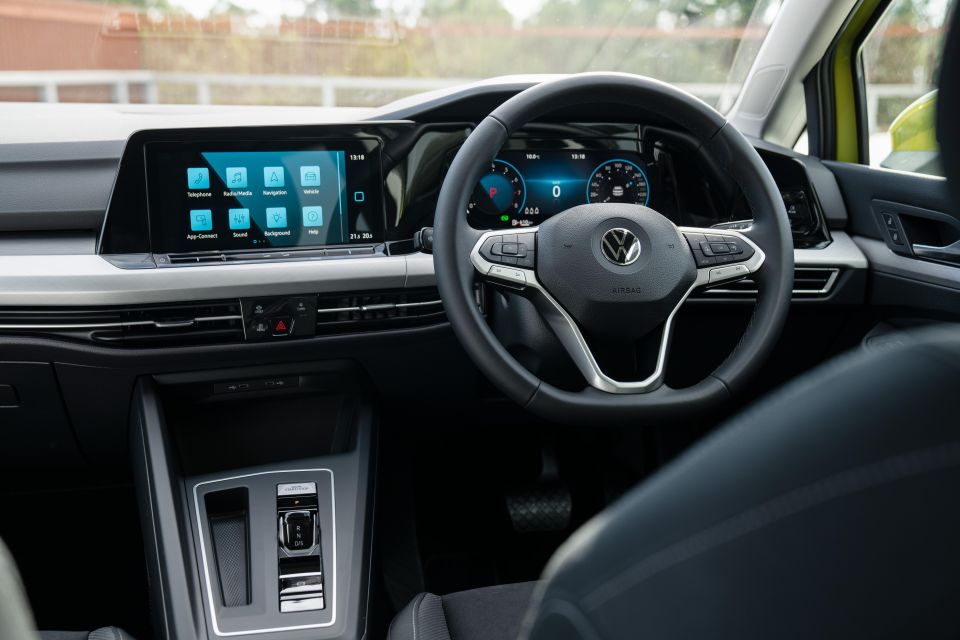
The Golf’s interior presents as somewhat spartan and austere in photos. In person, however, it’s refreshingly minimalist, looking recognisably Volkswagen while also looking fittingly modern.
It’s also a vastly nicer place to sit than the cabin of a T-Cross or T-Roc. Soft-touch plastics are used for the top of the dashboard and the front door trims, with upholstered inserts on all four doors.
Felt still lines the bottle holders. There’s also attractive, metal-look trim to provide contrast.
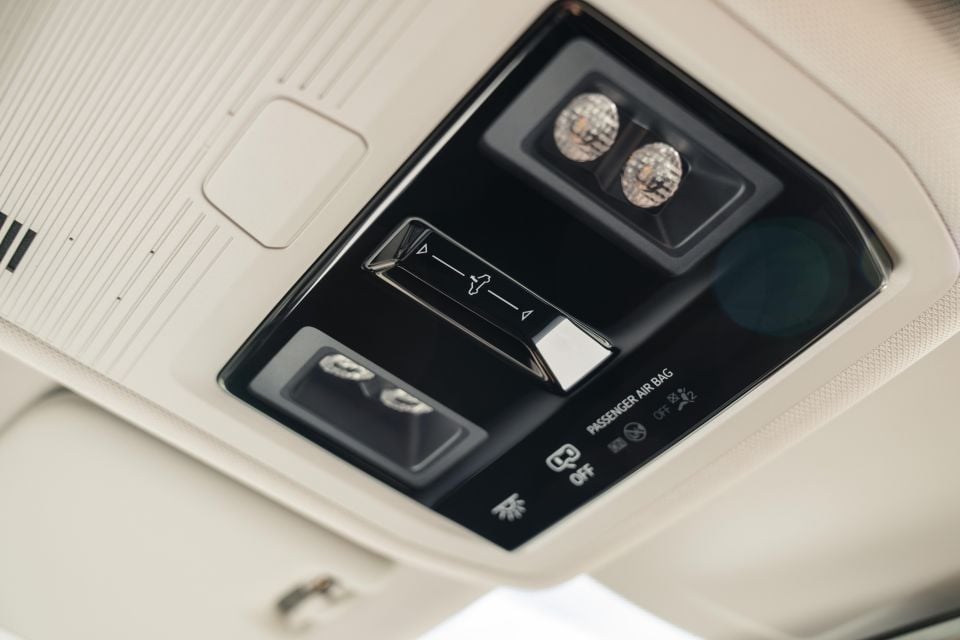

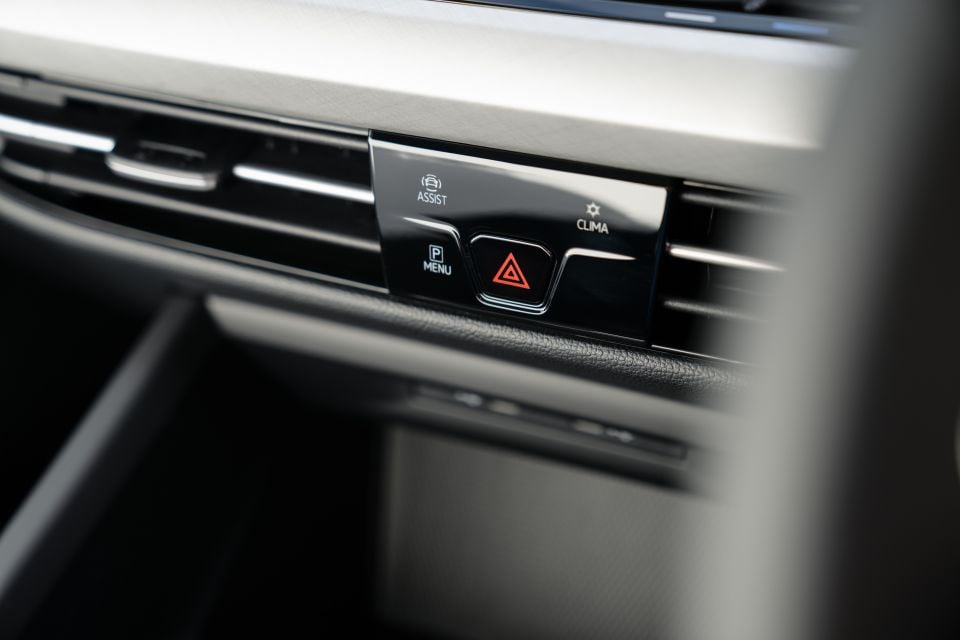
The minimalist look has been achieved primarily through the removal of physical climate controls, which we felt to be the cabin’s biggest drawback.
Touch-capacitive controls are used everywhere, from the headlight controls to the right of the steering wheel to the menu shortcuts (climate, parking and driver assist) below the centre stack and even the light switches on the roof. While these look neat, their benefits over conventional buttons are dubious, particularly as they lack haptic feedback.
At least these touch controls are less frequently used than the climate controls. There’s no physical button or dial for fan speed, so you’ll need to press the Climate button to adjust that via the touchscreen.
The temperature zones are controlled via a subtle slider below the touchscreen which is quite easy to accidentally set off should you have a habit of resting your fingers below the screen while you’re using it.
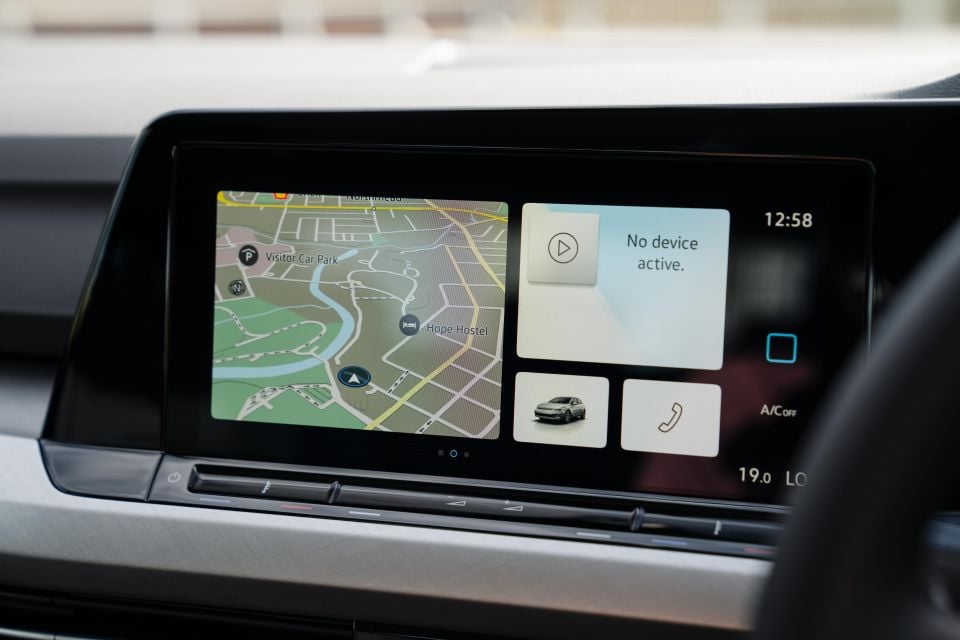
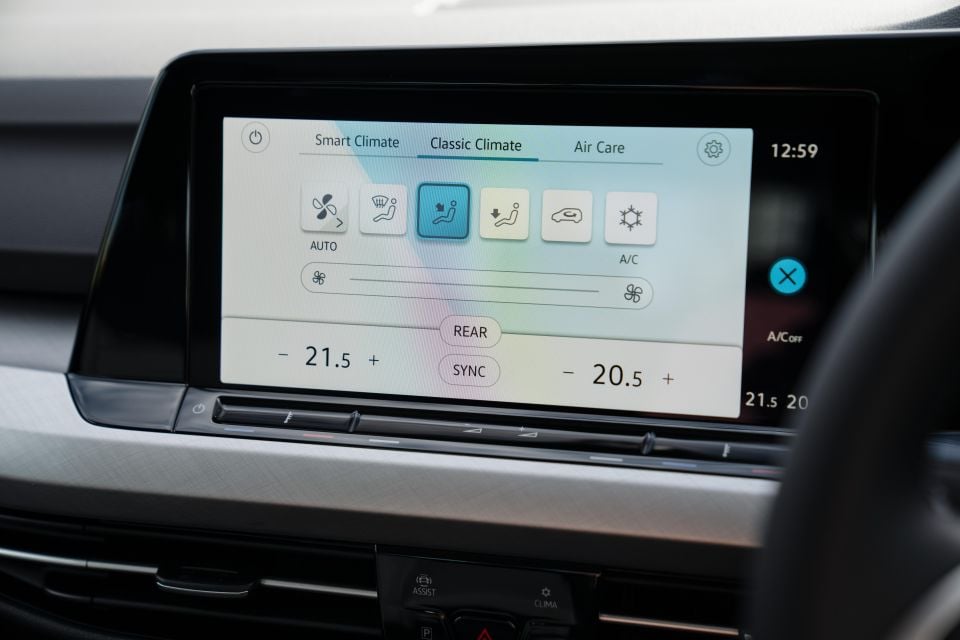
It’s an example where a more high-tech approach to a vehicle’s cabin isn’t necessarily the best approach, and you need look only at companies like Ford and General Motors in the US who rolled out similar touch-capacitive controls in the mid-2010s only to roll them back just a few years later.
Ultimately though, we feel that you will get used to it pretty quickly but physical buttons have remained a preference for us and that is unlikely to change.
Apart from that, the rest of the Volkswagen Golf’s in-car tech is top-notch. The touchscreen infotainment system has a classy user interface, sharp response times, a proper home screen, and wireless smartphone mirroring that makes great use of the screen’s real estate.


Then there’s the digital instrument cluster, which in Life models and up features satellite navigation, allowing you to view your surroundings without ever needing to look over at the touchscreen. That’s commendable in a segment where most rivals still lack the option of digital instruments.
They’re quite customisable, too. You can have a conventional dial layout, or you can replace it with a giant map view with two small boxes overlaid. For example, you can have the speed displayed in the right-hand side box and, say, your average fuel economy on the left-hand side. It’s all very slick and easy to customise, and everything is very clear and legible.
The head-up display is also very informative and easy to read, though we’d like to see traffic sign recognition in the Life.
The removal of conventional climate controls means the centre stack is scarcely a stack at all. Besides the aforementioned three touch-capacitive menu buttons, there are two USB-C outlets and then nothing until you reach the wireless charging pad.
The centre console is raked upwards towards the charging pad, and includes a rubberised storage area, the electric park brake, and the start button. It also houses the Golf’s shifter, which much like the one you will find in the new Porsche 911, we’re still getting use to.
It doesn’t take up that much less centre console real estate as a regular shifter but it takes some time to adjust to and it looks a little peculiar. Give us a dial or a regular shifter instead.
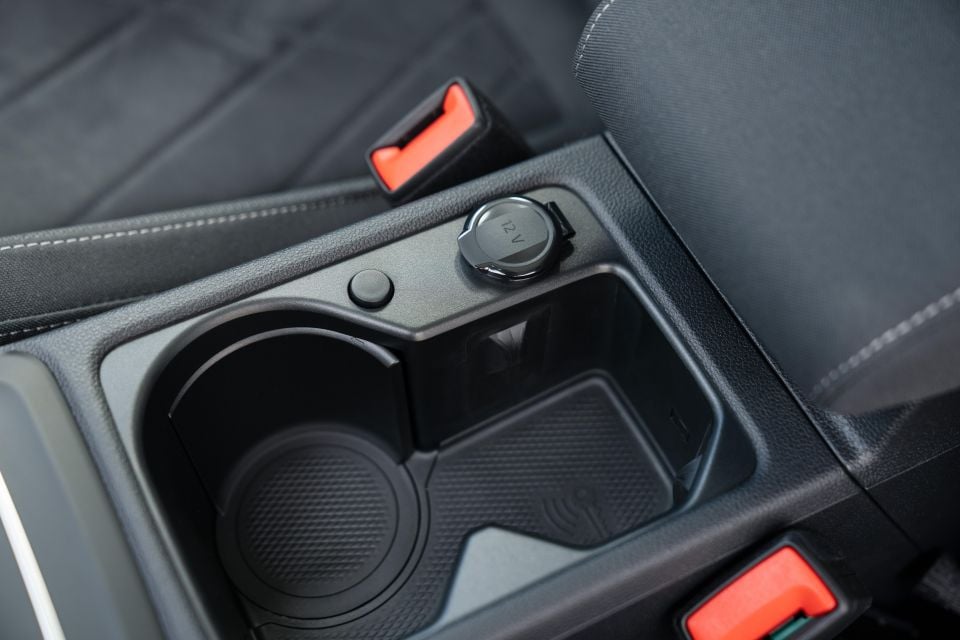

Where expert car reviews meet expert car buying – CarExpert gives you trusted advice, personalised service and real savings on your next new car.
Still, we appreciate the minimalist aesthetic Volkswagen was going for and the centre console does look thoroughly modern. There may not be any soft-touch plastic or leatherette on the sides, but the materials used are still quite nice.
Aft of the shifter area are two cupholders plus a centre console bin.
If you have a larger bottle that won’t fit in the cupholder, you’ll find the front door pockets can easily accommodate 1L bottles.
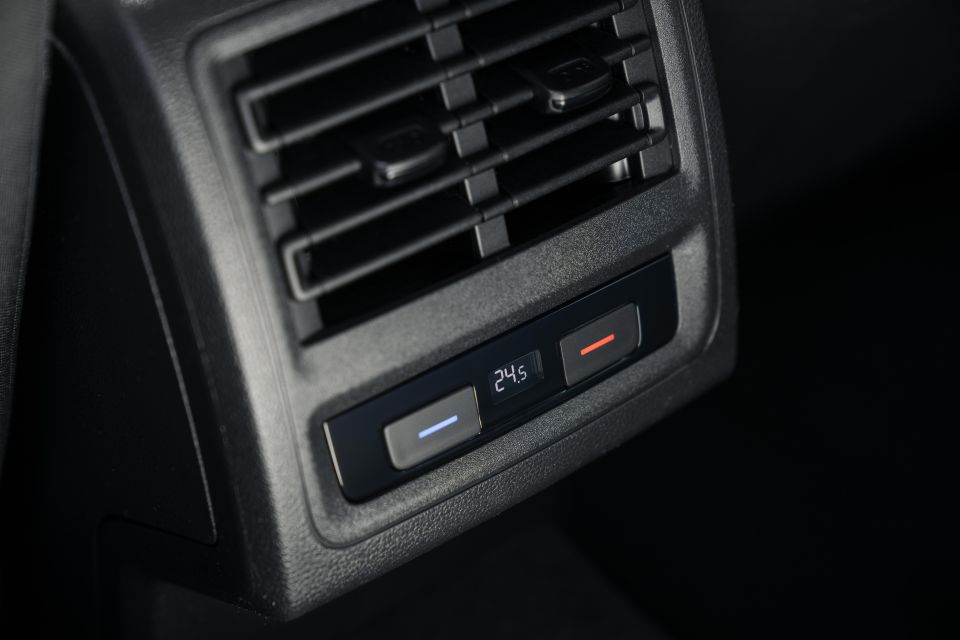
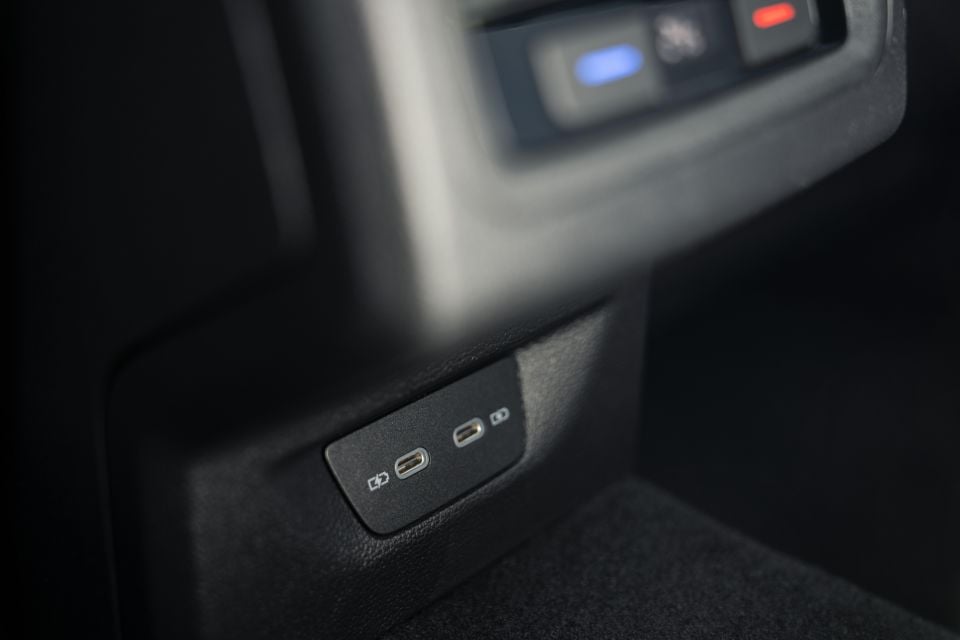

Shifting to the rear, the Golf still proves to be well-packaged, with the Mk8 featuring a 16mm wheelbase stretch.
There’s ample headroom, even with the Life’s sunroof, while a 180cm tall passenger can sit behind a similarly-sized driver, although any taller and you might run into some legroom issues. The centre-seat passenger will find space a bit tight, thanks to the centre tunnel and a centre console that juts out.
Rear seat occupants get two USB-C outlets, rear air vents plus their own climate control zone, adjustable via controls at the rear of the centre console.
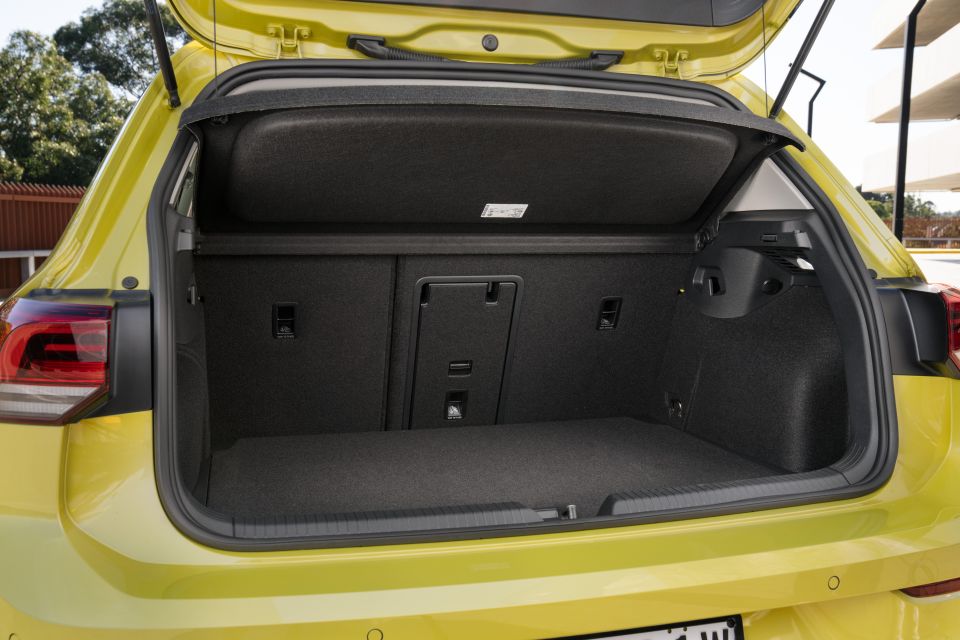
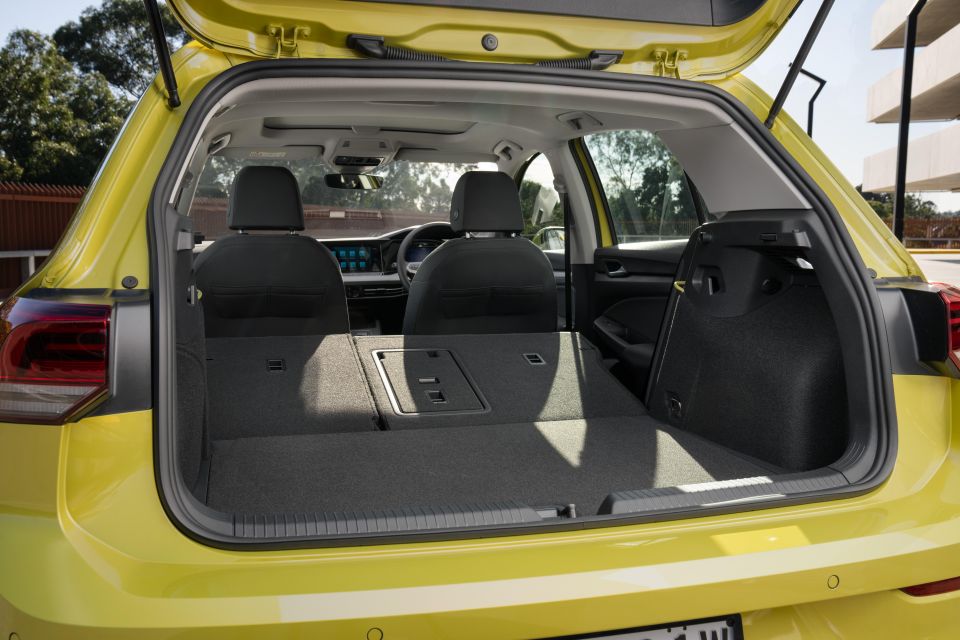
The boot has 374L of space, expanding to 1230L with the rear seats folded.
It’s easy to load and unload, though if you want more space Volkswagen will sell you the Golf Wagon – a rare body style in any segment, particularly in this one.
The Life adds a 12V power outlet to the boot, and all models come with a space-saver spare.
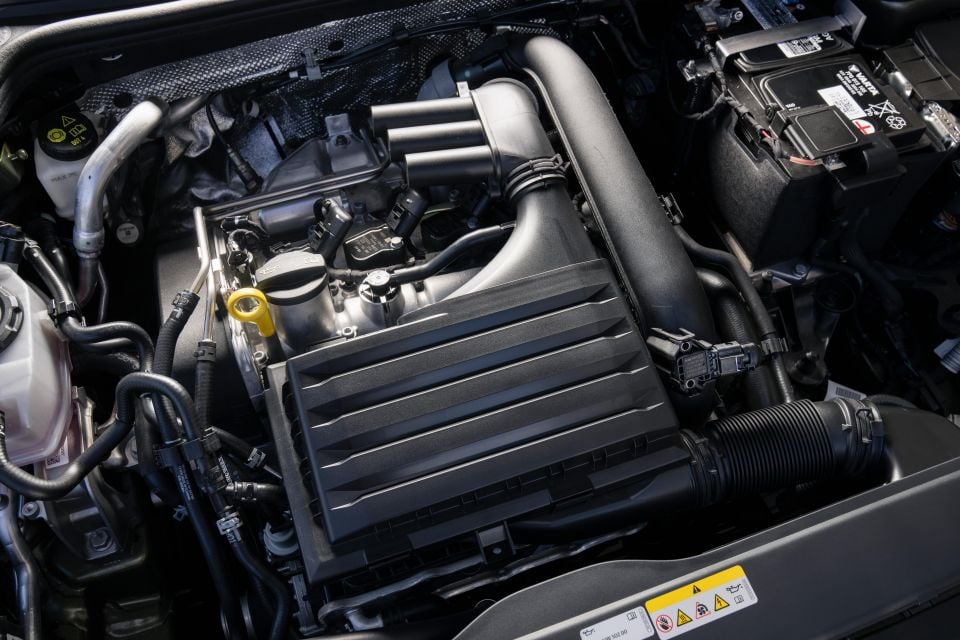
The core Mk8 Golf range in Australia is powered by a 1.4-litre turbocharged four-cylinder petrol engine, making 110kW of power and 250Nm of torque.
It’s mated to an eight-speed torque-converter automatic transmission, though a six-speed manual is available on the base model. All Australian-market Golfs, bar the upcoming R, are front-wheel drive.
Volkswagen claims a 0-100km/h time of 8.5 seconds for automatic 110TSI models, which feels about right.
The Golf’s power and torque figures stack up well against rivals, like the Focus ST-Line (134kW/240Nm), Mazda 3 G25 GT (138kW/252Nm), Impreza 2.0i-S (115kW/196Nm) and Civic RS (127kW/220Nm).
The i30 N Line has an edge, however, with 150kW and 265Nm.

It’s hard to fault the way the Mk8 Volkswagen Golf drives.
While the switch to a torque converter automatic may seem like a backwards step for some, the eight-speed automatic is well-matched to the car. It shifts quickly and smoothly and takes advantage of the Golf’s 1500-4000 rpm torque band, while feeling a little smoother off the line than a DSG.
If shifts weren’t quite as snappy at higher speeds as with a DSG, that wasn’t abundantly clear. There’ll always be people firmly in the dual-clutch camp, but for our money the new transmission is praiseworthy, if not better suited to a city car in this spec.
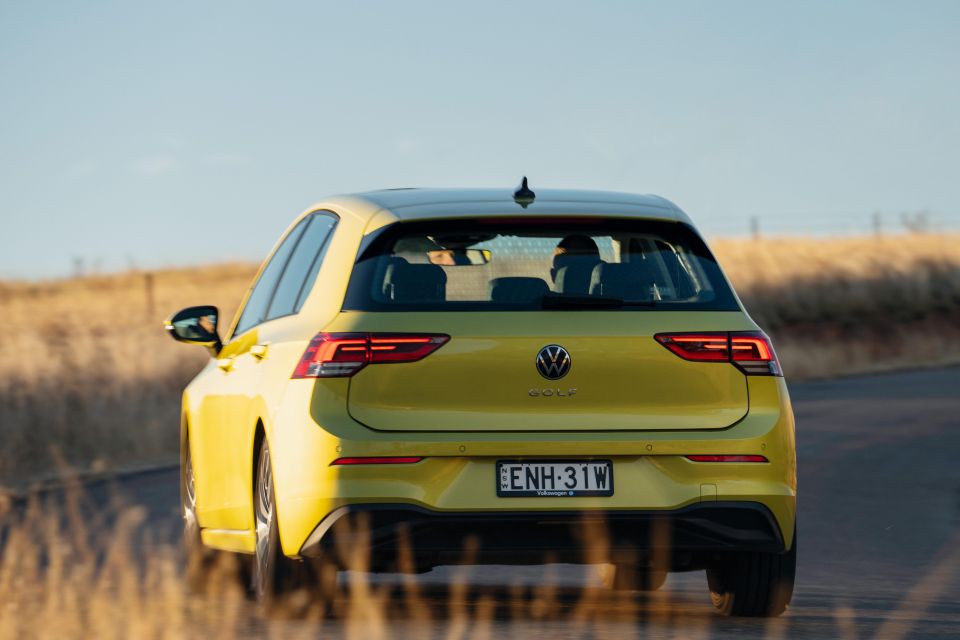
The turbocharged 1.4-litre isn’t a rocketship but there’s plenty of power for a small hatch. It’s smoother and more refined, too, than the powertrains found in rivals like the Hyundai i30 and Mazda 3.
You don’t need to wring the Golf quite as much as you would, say, a 2.0-litre Cerato. Should you do so, it has a more pleasant engine note and doesn’t sound coarse. That’s partially due to the lack of a petrol particulate filter which thankfully (for enthusiasts) Volkswagen still gets away with in Australia.
The impressive level of overall polish expected of a Golf is still present in the Mk8, whether you’re driving on a pockmarked city street or on a winding country road.
The Golf quickly quells large bumps and ruts and ride quality always remains comfortable. Volkswagen has employed an independent, four-link rear suspension with coil springs, even as rivals like the Mazda 3 have moved to a simpler torsion-beam rear axle.
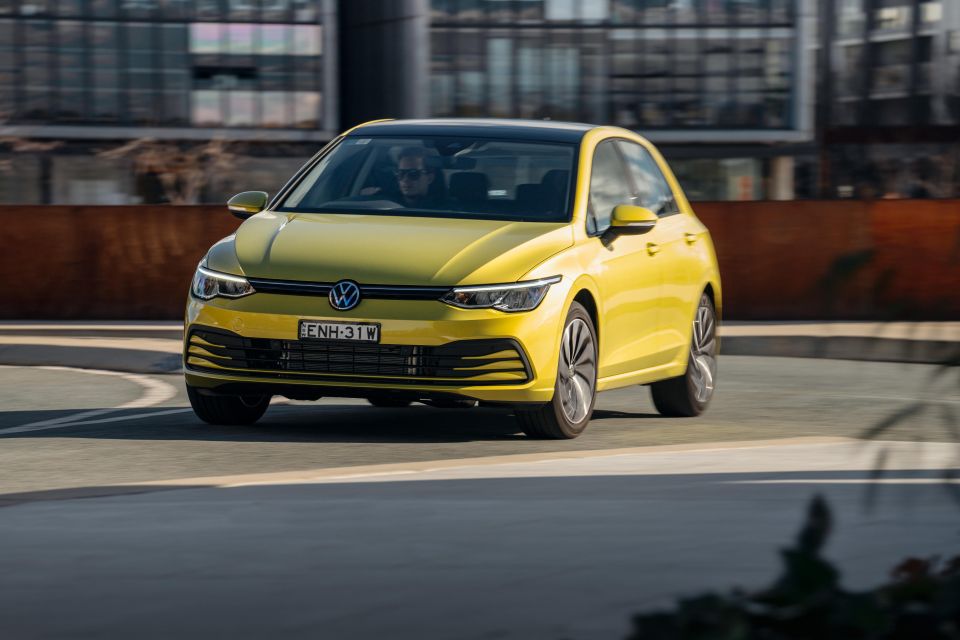
Turn-in is sharp, while the steering is satisfyingly hefty and communicative. The Golf stays flat in corners and boasts nice, neutral handling, and there’s enough driving enjoyment to be found here that you’ll want to take it to a mountain road.
Volkswagen offers its “Travel Assist” system as standard on the new Golf and we found it rather impressive during our testing on Sydney’s twisty roads. It’s a very simple feature to enable, with just one button on the steering wheel.
It easily maintained its set speed, inside its lane and with a healthy distance to the car in front. It’s one of the best example of Level 2 autonomous driving technology in the segment.
In all, the Golf Life offers a high level of ride comfort, handling ability and performance for the segment.

We averaged an indicated 7.3L/100km in mostly urban driving, against an ADR combined fuel economy figure of 5.8L/100km. The Golf requires 95RON premium unleaded fuel.
The combined figure is up 0.4L/100km compared to the Mk7.5 with the 1.4-litre and DSG.
The Golf is backed by a five-year, unlimited-kilometre warranty. Servicing is required every 12 months or 15,000km and Volkswagen offers three- and five-year pre-paid service packages for $1100 or $1900 respectively.
By comparison, a Mazda 3 G25 GT costs $1692 over five years, while a Corolla ZR’s first four services are capped at just $180, a Focus ST-Line’s first four services are $299 a pop and an i30 N Line’s first five are $299 each. That puts the Golf at the pricier end of the segment.
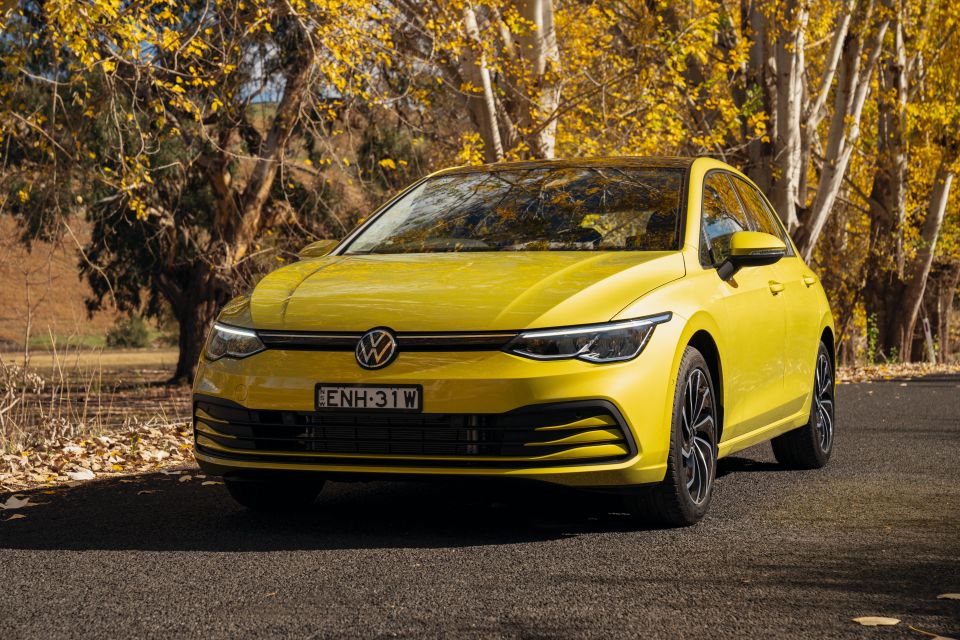
The new Volkswagen Golf’s redesign perhaps isn’t as controversial as it first appeared.
The styling is more resolved in person, while the interior is fortunately far removed from that of the T-Cross and T-Roc and is both more attractive and better-made.
We don’t like the over-reliance on the touchscreen and on touch-capacitive controls that lack haptic feedback, but it’s by no means a deal breaker and the in-car tech is otherwise top-notch.
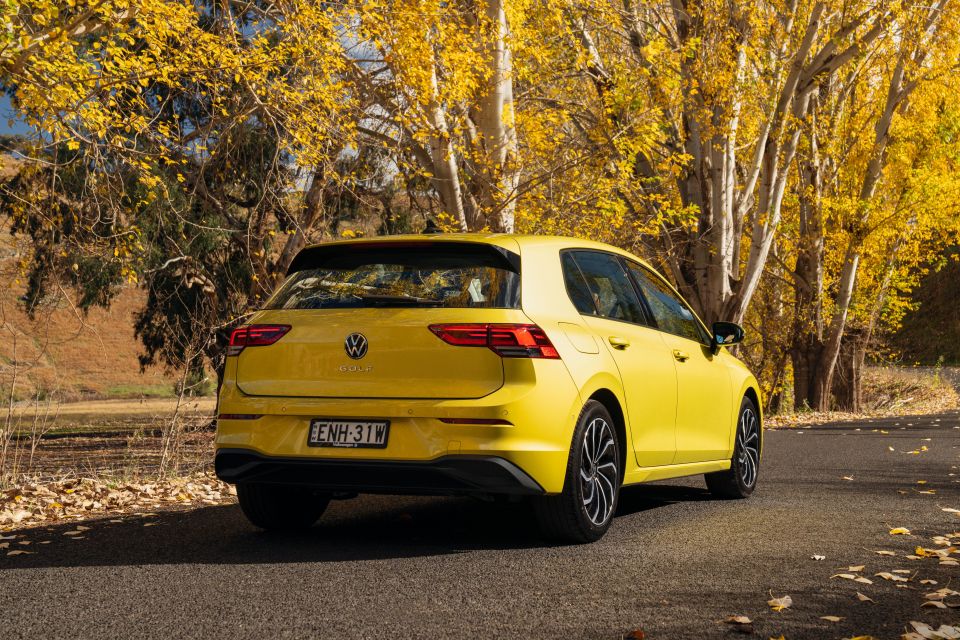
While the Volkswagen Golf is pricier than before, it still stacks up well against its competition (especially against its Skoda rival, funnily enough) and packs more standard equipment than the old car. That the IQ. Drive suite of technology is standard from the base level is commendable.
There’s also still that basic Golf goodness, with a polished ride/handling balance and a smooth powertrain that is none the worse for having dropped the dual-clutch auto.
The Golf has long been a benchmark in the European C-segment plus a consistent top-seller. A higher base price and increasing movement to SUVs over here in Australia may dent Golf sales but the Mk8 should still be at the top of your list if you’re in the market for a circa-$35k hatchback.

Click the images for the full gallery
Where expert car reviews meet expert car buying – CarExpert gives you trusted advice, personalised service and real savings on your next new car.
William Stopford is an automotive journalist with a passion for mainstream cars, automotive history and overseas auto markets.


Damion Smy
5 Days Ago
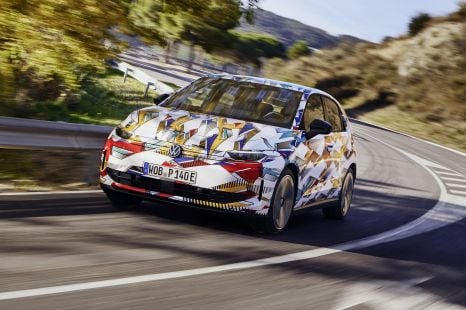

William Stopford
12 Days Ago
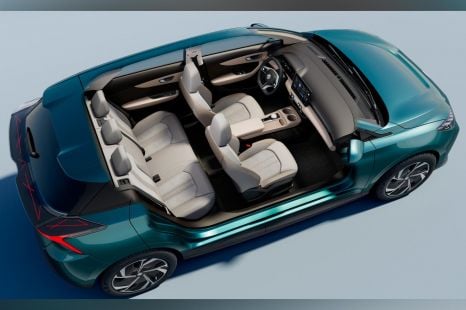

William Stopford
13 Days Ago
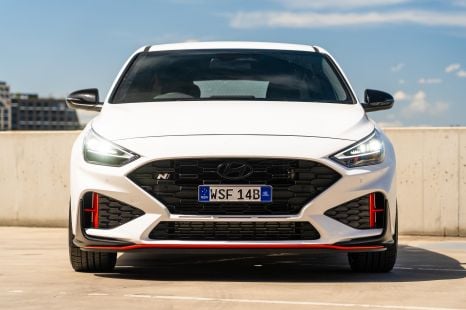

William Stopford
19 Days Ago
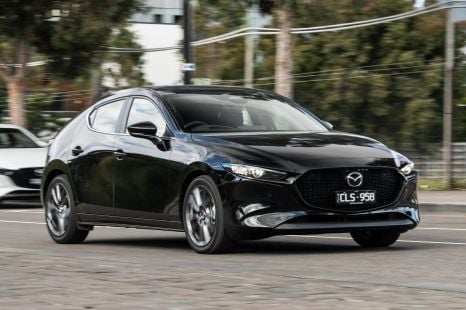

Josh Nevett
27 Days Ago
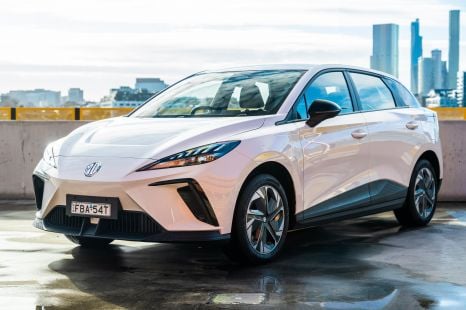

William Stopford
1 Month Ago